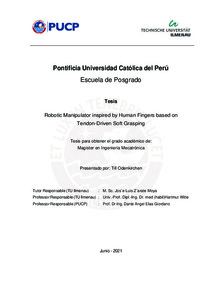| dc.contributor.advisor | Elías Giordano, Dante Ángel | es_ES |
| dc.contributor.author | Odenkirchen, Till | |
| dc.date.accessioned | 2021-11-26T21:44:35Z | |
| dc.date.available | 2021-11-26T21:44:35Z | |
| dc.date.created | 2021 | |
| dc.date.issued | 2021-11-26 | es_ES |
| dc.identifier.uri | http://hdl.handle.net/20.500.12404/21008 | |
| dc.description.abstract | Die menschliche Hand ist in der Lage, verschiedene Greif- und Manipulationsaufgaben auszuführen und kann als einer der geschicktesten und vielseitigsten Effektoren angesehen werden.
In dieser Arbeit wurde ein Soft Robotic-Greifer entwickelt, der auf den Erkenntnissen aus der Literatur zur Taxonomie der menschlichen Greiffähigkeiten und den biomechanischen Synergien der menschlichen Hand basiert. Im Bereich der Roboterhände sind sehnengetriebene, unteraktuierte Strukturen weit verbreitet. Inspiriert von der Anatomie der menschlichen Hand, bieten sie durch ihre Flexibilität passive Adaptivität und Robustheit. Es wurde ein Sensorsystem implementiert, bestehend aus Force Sensing Resistors (FSRs), Biegungssensoren und einem Stromsensor, wodurch das System charakterisiert werden kann. Die Kraftsensoren wurden in die Fingerkuppen integriert. In Anlehnung an die menschliche Haut wurden Abgüsse aus Silikonkautschuk an den Fingerballen verwendet. Diese versprechen eine erhöhte Reibung und bessere Adaptivität zum gegriffenen Objekt. Um den entwickelten Greifer zu evaluieren, wurden erste Tests durchgeführt. Zunächst wurde die Funktionalität der Sensoren, wie z.B. der als FSRs ausgewählten Kraftsensoren, getestet. Im weiteren Verlauf wurden die Greiffähigkeiten des Greifers durch Manipulation verschiedener Objekte getestet. Basierend auf den Erkenntnissen aus den praktischen Versuchen kann festgestellt werden, dass der entwickelte Greifer ein hohes Maß an Geschicklichkeit aufweist. Auch die Adaptivität ist dank der verwendeten mechanischen Komponenten gewährleistet. Mittels der Sensorik ist es möglich, den Greifprozess zu kontrollieren. Die Ergebnisse zeigen aber auch, dass z. B. die interne Systemreibung die Verlustleistung des Systems stark beeinflusst. | es_ES |
| dc.description.abstract | The human hand is able to perform various grasping and manipulation tasks, and can be seen as one of the most dexterous and versatile effectors known. The prehensile capabilities of the hand have already been analyzed, categorized and summarized in a taxonomy in numerous studies. In addition to the taxonomies, research on the biomechanical synergies of the human hand led to the following conceptions: The adduction/abduction movement is independent of the flexion/extension movement. Furthermore, the thumb is rather independent in its mobility from the other fingers, while those move synchronously within their corresponding joints. Lastly, the consideration of the synergies provides that the proximal and distal interphalangeal joints of a human finger are more intensely coordinated than those of the metacarpal joints. In this work, a soft robotic gripper was developed based on the knowledge from the literature on the taxonomy of human gripping abilities and the biomechanical synergies of the human hand. In the domain of robotic hands, tendon-driven underactuated structures are widely used. Inspired by the tensegrity structure of the human hand, they offer passive adaptivity and robustness through their flexibility. A sensor system was implemented, consisting of FSRs, flex sensors and a current sensor, thus the system parameters can be characterized continously. The force sensors were integrated into the fingertips. Molds of silicone rubber were used as finger pads to provide higher friction and better adaptivity to the grasped object on the contact areas of the finger, to mimic human skin. Initial tests were carried out to evaluate the gripper. First, the functionality of the sensors, such as the force sensors selected as FSRs, was tested. In the further course, the gripping capabilities of the gripper were tested by manipulation of various different objects. Based on the findings from the practical experiments, it may be stated that the gripper has a high degree of dexterity. Thanks to the mechanical components used, adaptivity is guaranteed as well. By means of the sensor system it is possible to control the gripping processes. However, the results also showed that, for example, the internal system friction dominates the system’s power dissipation. | es_ES |
| dc.language.iso | eng | es_ES |
| dc.publisher | Pontificia Universidad Católica del Perú | es_ES |
| dc.rights | info:eu-repo/semantics/openAccess | es_ES |
| dc.rights.uri | http://creativecommons.org/licenses/by-nc-sa/2.5/pe/ | * |
| dc.subject | Manipuladores (Mecanismos)--Diseño y construcción | es_ES |
| dc.subject | Robótica | es_ES |
| dc.subject | Sensores inteligentes | es_ES |
| dc.title | Robotic manipulator inspired by human fingers based on tendon-driven soft grasping | es_ES |
| dc.type | info:eu-repo/semantics/masterThesis | es_ES |
| thesis.degree.name | Maestro en Ingeniería Mecatrónica | es_ES |
| thesis.degree.level | Maestría | es_ES |
| thesis.degree.grantor | Pontificia Universidad Católica del Perú. Escuela de Posgrado. | es_ES |
| thesis.degree.discipline | Ingeniería Mecatrónica | es_ES |
| renati.advisor.dni | 10142907 | |
| renati.advisor.orcid | https://orcid.org/0000-0001-5920-9608 | es_ES |
| renati.author.pasaporte | CH9WP04YP | |
| renati.discipline | 713167 | es_ES |
| renati.juror | Tafur Sotelo, Julio Cesar | |
| renati.juror | Elías Giordano, Dante Ángel | |
| renati.juror | Zárate Moya, José Luis | |
| renati.level | https://purl.org/pe-repo/renati/level#maestro | es_ES |
| renati.type | https://purl.org/pe-repo/renati/type#tesis | es_ES |
| dc.publisher.country | PE | es_ES |
| dc.subject.ocde | https://purl.org/pe-repo/ocde/ford#2.00.00 | es_ES |






